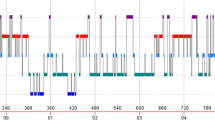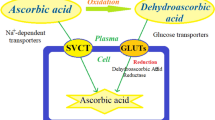Abstract
Purpose
Obstructive sleep apnea syndrome (OSAS) is characterized by elevated oxidative stress. Measurement of oxidative stress in saliva seems to be promising in long-term treatment monitoring of OSAS patients. In this study, our aim was to investigate whether short-term continuous positive airway pressure (CPAP) treatment would influence oxidative stress in saliva.
Methods
Patients with diagnosed OSAS (16 women, 28 men) underwent polysomnography during the first night and CPAP treatment during the second night. Saliva samples were taken in the evening and morning on both days. Markers of oxidative stress and antioxidant status were analyzed in saliva.
Results
Evening concentrations of the salivary thiobarbituric acid reacting substances (p < 0.001), advanced glycation end-products (p < 0.001), and advanced oxidation protein products (p < 0.01) were significantly lower than morning values during the diagnostic night. However, salivary concentrations of none of the oxidative stress markers were significantly influenced by the CPAP treatment. No changes in salivary antioxidant status after CPAP therapy were found.
Conclusion
Salivary markers of oxidative stress and antioxidant status do not change significantly after one night treatment with CPAP. On the contrary, after 1 month with CPAP therapy, reduced markers of oxidative stress were reported. Therefore, the future studies should be focused on finding the optimal sampling frequency to clarify the potential of saliva for the monitoring of OSAS treatment.





Similar content being viewed by others
References
Mirrakhimov AE, Sooronbaev T, Mirrakhimov EM (2013) Prevalence of obstructive sleep apnea in Asian adults: a systematic review of the literature. BMC Pulm Med 13:10
Lavie P, Herer P, Hoffstein V (2000) Obstructive sleep apnoea syndrome as a risk factor for hypertension: population study. BMJ 320:479–482
Parish JM, Adam T, Facchiano L (2007) Relationship of metabolic syndrome and obstructive sleep apnea. J Clin Sleep Med 3:467–472
Mehra R, Redline S (2008) Sleep apnea: a proinflammatory disorder that coaggregates with obesity. J Allergy Clin Immunol 121:1096–1102
Gharibeh T, Mehra R (2010) Obstructive sleep apnea syndrome: natural history, diagnosis, and emerging treatment options. Nat Sci Sleep 2:233–255
Jurkovicova I, Celec P, Mucska I, Hodosy J (2003) On the origin of cardiovascular complications of sleep apnea syndrome by the means of molecular interactions. Bratisl Lek Listy 104:167–173
Wang Y, Zhang SX, Gozal D (2010) Reactive oxygen species and the brain in sleep apnea. Respir Physiol Neurobiol 174:307–316
Lavie L (2003) Obstructive sleep apnoea syndrome—an oxidative stress disorder. Sleep Med Rev 7:35–51
Zhang J, Veasey S (2012) Making sense of oxidative stress in obstructive sleep apnea: mediator or distracter? Front Neurol 3:179
Lavie L, Vishnevsky A, Lavie P (2004) Evidence for lipid peroxidation in obstructive sleep apnea. Sleep 27:123–128
Mancuso M, Bonanni E, LoGerfo A, Orsucci D, Maestri M, Chico L, DiCoscio E, Fabbrini M, Siciliano G, Murri L (2012) Oxidative stress biomarkers in patients with untreated obstructive sleep apnea syndrome. Sleep Med 13:632–636
Ntalapascha M, Makris D, Kyparos A, Tsilioni I, Kostikas K, Gourgoulianis K, Kouretas D, Zakynthinos E (2013) Oxidative stress in patients with obstructive sleep apnea syndrome. Sleep Breath 17:549–555
Kang IG, JungKim ST JH, Kim ST (2013) The effect of obstructive sleep apnea on DNA damage and oxidative stress. Clin Exp Otorhinolaryngol 6:68–72
Baessler A, Nadeem R, Harvey M, Madbouly E, Younus A, Sajid H, Naseem J, Asif ABawaadam H (2013) Treatment for sleep apnea by continuous positive airway pressure improves levels of inflammatory markers—a meta-analysis. J Inflamm (Lond) 10:13
Minoguchi K, Yokoe T, Tanaka A, Ohta S, Hirano T, Yoshino G, O'Donnell CP, Adachi M (2006) Association between lipid peroxidation and inflammation in obstructive sleep apnoea. Eur Respir J 28:378–385
Christou K, Kostikas K, Pastaka C, Tanou K, Antoniadou I, Gourgoulianis KI (2009) Nasal continuous positive airway pressure treatment reduces systemic oxidative stress in patients with severe obstructive sleep apnea syndrome. Sleep Med 10:87–94
Singh TD, Patial K, Vijayan VK, Ravi K (2009) Oxidative stress and obstructive sleep apnoea syndrome. Indian J Chest Dis Allied Sci 51:217–224
Svatikova A, Wolk R, Lerman LO, Juncos LA, Greene EL, McConnell JP, Somers VK (2005) Oxidative stress in obstructive sleep apnoea. Eur Heart J 26:2435–2439
Kamodyova N, Celec P (2011) Salivary markers of oxidative stress and Salivette collection systems. Clin Chem Lab Med 49:1887–1890
Celecova V, Kamodyova N, Tothova L, Kudela M, Celec P (2013) Salivary markers of oxidative stress are related to age and oral health in adult non-smokers. J Oral Pathol Med 42:263–266
Celec P, Hodosy J, Behuliak M, Palffy R, Gardlik R, Halcak L, Mucska I (2012) Oxidative and carbonyl stress in patients with obstructive sleep apnea treated with continuous positive airway pressure. Sleep Breath 16:393–398
Alzoghaibi MA, Bahammam AS (2012) The effect of one night of continuous positive airway pressure therapy on oxidative stress and antioxidant defense in hypertensive patients with severe obstructive sleep apnea. Sleep Breath 16:499–504
Tothova L, Ostatnikova D, Sebekova K, Celec P, Hodosy J (2013) Sex differences of oxidative stress markers in young healthy subjects are marker-specific in plasma but not in saliva. Ann Hum Biol 40:175–180
Del Ben M, Fabiani M, Loffredo L, Polimeni L, Carnevale R, Baratta F, Brunori M, Albanese F, Augelletti T, Violi F, Angelico F (2012) Oxidative stress mediated arterial dysfunction in patients with obstructive sleep apnoea and the effect of continuous positive airway pressure treatment. BMC Pulm Med 12:36
Karamanli H, Ozol D, Ugur KS, Yildirim Z, Armutcu F, Bozkurt BYigitoglu R (2012) Influence of CPAP treatment on airway and systemic inflammation in OSAS patients. Sleep Breath. doi: 10.1007/s11325-012-0761-8c
Poljsak B (2011) Strategies for reducing or preventing the generation of oxidative stress. Oxid Med Cell Longev 2011:194586. doi:10.1155/2011/194586
Sasaki S, Matsuura T, Takahashi R, Iwasa T, Watanabe H, Shirai K, Nakamoto H, Goto S, Akita S, Kobayashi Y (2013) Effects of regular exercise on neutrophil functions, oxidative stress parameters and antibody responses against 4-hydroxy-2-nonenal adducts in middle aged humans. Exerc Immunol Rev 19:60–71
Bjelakovic G, Nikolova D, Gluud C (2013) Meta-regression analyses, meta-analyses, and trial sequential analyses of the effects of supplementation with beta-carotene, vitamin a, and vitamin e singly or in different combinations on all-cause mortality: do we have evidence for lack of harm? PLoS One 8:e74558
Pollanen MT, Paino A, AIhalin R (2013) Environmental stimuli shape biofilm formation and the virulence of periodontal pathogens. Int J Mol Sci 14:17221–17237
Shpitzer T, Hamzany Y, Bahar G, Feinmesser R, Savulescu D, Borovoi I, Gavish M, Nagler RM (2009) Salivary analysis of oral cancer biomarkers. Br J Cancer 101:1194–1198
Vlkova B, Stanko P, Minarik G, Tothova L, Szemes T, Banasova L, Novotnakova D, Hodosy J, Celec P (2012) Salivary markers of oxidative stress in patients with oral premalignant lesions. Arch Oral Biol 57:1651–1656
Hegde AM, Rai K, Padmanabhan V (2009) Total antioxidant capacity of saliva and its relation with early childhood caries and rampant caries. J Clin Pediatr Dent 33:231–234
Su H, Velly AM, Salah MH, Benarroch M, Trifiro M, Schipper HM, Gornitsky M (2012) Altered redox homeostasis in human diabetes saliva. J Oral Pathol Med 41:235–241
Behuliak M, Palffy R, Gardlik R, Hodosy J, Halcak L, Celec P (2009) Variability of thiobarbituric acid reacting substances in saliva. Dis Markers 26:49–53
Kamodyova N, Tothova L, Celec P (2013) Salivary markers of oxidative stress and antioxidant status: influence of external factors. Dis Markers 34:313–321
Quintero M, Gonzalez-Martin MD, Vega-Agapito V, Gonzalez C, Obeso A, Farre R, Agapito T, Yubero S (2013) The effects of intermittent hypoxia on redox status, NFkappaB activation, and plasma lipid levels are dependent on the lowest oxygen saturation. Free Radic Biol Med 65:1143–1154
Force TRoaAAoSMT (1999) Sleep-related breathing disorders in adults: recommendations for syndrome definition and measurement techniques in clinical research. Sleep 22:667–689
Pendyala G, Thomas B, Joshi SR (2013) Evaluation of total antioxidant capacity of saliva in type 2 diabetic patients with and without periodontal disease: a case–control study. N Am J Med Sci 5:51–57
Carpagnano GE, Kharitonov SA, Resta O, Foschino-Barbaro MP, Gramiccioni E, Barnes PJ (2002) Increased 8-isoprostane and interleukin-6 in breath condensate of obstructive sleep apnea patients. Chest 122:1162–1167
Franco CM, Lima AM, Ataide L Jr, Lins OG, Castro CM, Bezerra AA, de Oliveira MF, Oliveira JR (2012) Obstructive sleep apnea severity correlates with cellular and plasma oxidative stress parameters and affective symptoms. J Mol Neurosci 47:300–310
Acknowledgments
This study was funded by the Slovak Ministry of Education, Science, Research and Sport—grant number VEGA 1/0674/12. We would like to thank the anonymous reviewers for their constructive approach.
Conflict of interest
No conflict of interest to declare.
Author information
Authors and Affiliations
Corresponding author
Rights and permissions
About this article
Cite this article
Tóthová, L., Hodosy, J., Mucska, I. et al. Salivary markers of oxidative stress in patients with obstructive sleep apnea treated with continuous positive airway pressure. Sleep Breath 18, 563–570 (2014). https://doi.org/10.1007/s11325-013-0919-z
Received:
Revised:
Accepted:
Published:
Issue Date:
DOI: https://doi.org/10.1007/s11325-013-0919-z




